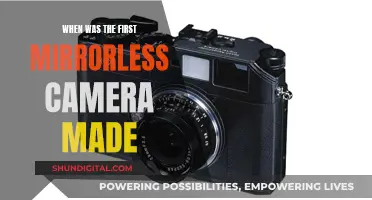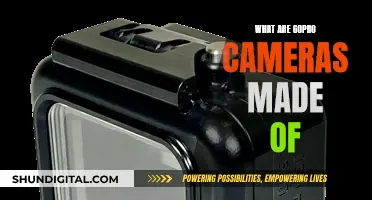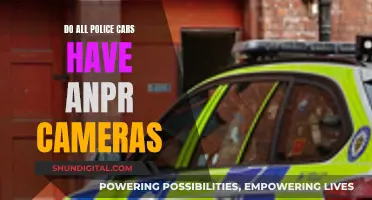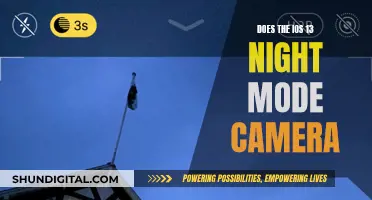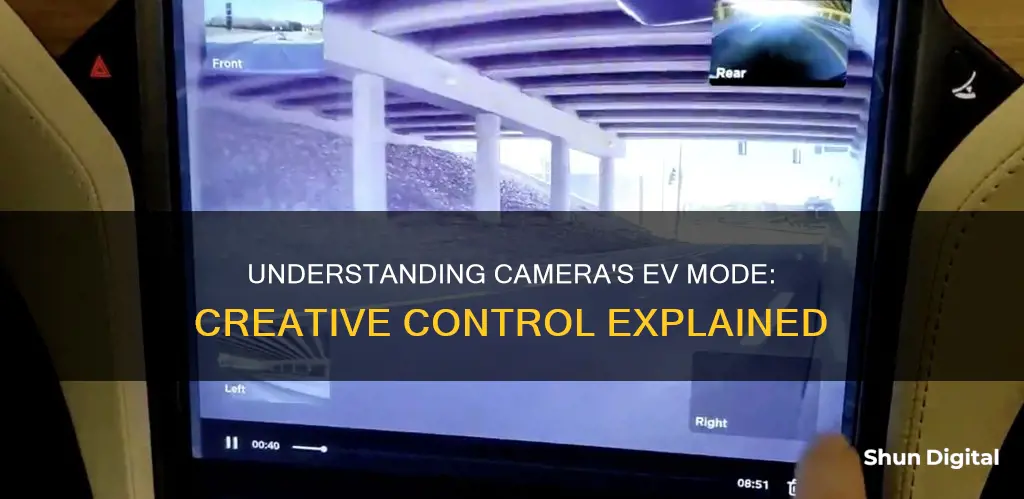
Exposure value (EV) is a number that combines a camera's shutter speed and f-number to indicate the amount of light in a scene. It is used to determine the correct exposure settings to ensure an image is not too bright or too dark. While modern cameras have made the practical use of EV largely obsolete, understanding the concept is essential to comprehending the relationship between aperture, shutter speed, and ISO, also known as the exposure triangle.
What You'll Learn

How to calculate exposure value
Exposure Value (EV) is a number that represents the combination of a camera's shutter speed and aperture to achieve the correct exposure. It is calculated using the formula:
> EV = log2(N^2 / t)
Where N is the f-number (or f-stop number) and t is the shutter speed in seconds. This formula gives the Exposure Value for a given combination of aperture and shutter speed at ISO 100.
The Exposure Value increases with a decrease in the f-stop number (widening the aperture) or a decrease in shutter speed (allowing light to reach the camera sensor for longer). Conversely, the Exposure Value decreases with an increase in the f-stop number (closing the aperture) or an increase in shutter speed (reducing the time the sensor is exposed to light).
Each increment of 1 in exposure value corresponds to a change of one "step" or "stop" in exposure—either halving or doubling the amount of light. A higher EV means you are exposing for a brighter subject, and a lower EV is used for darker subjects.
The Exposure Value system was developed to simplify the process of choosing the right camera settings for a given lighting condition. It allows photographers to quickly adjust their settings without having to make complex mental calculations.
Charging the Kodak Easyshare C1450: A Simple Guide
You may want to see also

Exposure value in real-world situations
The exposure value (EV) is a number that combines a camera's shutter speed and aperture to achieve the correct exposure in an image. While it is not necessary to calculate in modern photography, it is still a useful concept to understand.
- EV 15 is good for a bright, sunny day with clear skies. Ideal settings are an aperture of f/16 with a shutter speed of 1/125 second at ISO 100.
- EV 12 is suitable for an overcast day or a scene in the shade on a sunny day. Use an aperture of f/4 with a shutter speed of 1/250 second at ISO 100.
- EV 8 is appropriate for an indoor scene with window light or an outdoor scene during sunset. Try an aperture of f/4 with a shutter speed of 1/15 second at ISO 100.
- EV 4 works for home interior lighting or dim outdoor conditions. Choose an aperture of f/2.8 with a shutter speed of 1/2 second at ISO 100.
- EV 0 is suitable for night landscapes under moonlight. Use an aperture of f/2.8 with a shutter speed of 8 seconds at ISO 100.
The above examples assume an ISO of 100, which is the standard used in EV charts. However, if you want to increase the ISO, you will need to adjust the aperture or shutter speed to maintain the same EV. For example, if you increase the ISO from 100 to 200, you will need to either close the aperture to f/22 or halve the shutter speed to 1/250 second to keep the same EV of 15.
In addition to the above, EV can also be useful in understanding a camera's capabilities, such as its metering or autofocusing abilities in low-light conditions.
How to Find the Crop Tool in Camera Raw?
You may want to see also

How ISO affects exposure value
Exposure Value (EV) is a way to express a combination of a camera's shutter speed and aperture as a single value. Each time you increase or decrease the EV by one value (or one "stop"), you are capturing half or twice as much light.
ISO is the third pillar of photography, alongside shutter speed and aperture. It is a camera setting that brightens or darkens a photo. As you increase the ISO number, your photos will grow progressively brighter. However, ISO is not a variable of exposure because it doesn't affect the amount of light the image sensor receives. Instead, ISO settings determine how brightly the camera renders a picture given the exposure you have set using the aperture and shutter speed.
ISO lets you change picture brightness without further adjusting your aperture or shutter settings, or changing the lighting in the scene. It is common to raise the ISO when achieving an ideal exposure by other means is not feasible. When you increase the ISO beyond the image sensor's base sensitivity (typically ISO 100 or 200), the camera underexposes the image sensor and then amplifies that signal to render an image of the correct exposure. The extent of the image sensor's underexposure is proportional to how many stops your ISO setting deviates from its base value.
For example, if you take a picture using ISO 3200 and your camera's base is ISO 200, the camera will render the final image from an exposure that's four stops too dark. In this case, the ISO setting will have a significant effect on the exposure value.
However, raising the ISO to increase picture brightness also increases image noise. There are three types of noise in digital cameras: read noise, shot noise, and thermal noise. Shot noise increases with lower light exposure, such as when using high ISO values or underexposing your pictures. Therefore, while ISO can be used to affect exposure value, it is not always desirable to do so due to the potential impact on image quality.
Charging the Bdpower Wi-Fi Camera: A Step-by-Step Guide
You may want to see also

Exposure value and semi-automatic modes
Exposure Value (EV) is a way to represent the combination of a camera's shutter speed and f-number as a single value. It is calculated using the formula:
> EV = log2(N^2/t)
Where N is the f-number and t is the shutter speed in seconds. The higher the EV, the brighter the scene.
In the past, photographers used to rely on their eyes and trial and error to figure out the correct camera settings. They would use light meters or their personal experience to judge the amount of light in a scene and then refer to an EV chart to determine the corresponding camera settings.
Today, digital cameras have a built-in light meter to measure the EV in the scene. This information is included in the EXIF data for each image. Photographers can use semi-automatic modes like Aperture Priority (Av) and Shutter Priority (Tv) to let the camera adjust the other settings to achieve the desired EV.
Exposure Compensation
Exposure compensation allows photographers to adjust the brightness of their images by changing the exposure variables (aperture, shutter speed, and ISO). This is useful when the camera's meter fails to produce the desired exposure, such as in scenes with snow or at night. It is also used to create artistic effects, such as silhouettes or exposing for highlights.
To use exposure compensation, set your camera to Aperture Priority, Shutter Priority, or Program mode. Then, evaluate the scene and determine the necessary compensation. Find the +/- button on your camera and dial in the desired amount of compensation. Take a shot and review the image to see if any further adjustments are needed.
The Power of Wyze Cameras: Battery or Plug-in?
You may want to see also

Exposure compensation and the exposure triangle
The exposure triangle is a visual aid that illustrates the co-dependent relationship between a camera's three manual settings: aperture, shutter speed, and ISO. These settings work together to control how your photograph is created, specifically, the amount of light needed to expose your photograph properly.
Each side of the exposure triangle represents one of these three settings, and the goal is to balance them harmoniously to expose the scene in front of you based on the amount of available light.
The three settings need to work together to get your photograph in the "bulls-eye" zone, which represents the correct amount of light needed for adequate exposure. This zone has some flexibility, depending on the dynamic range of your scene (the range of bright and dark tones) and the dynamic range of your camera sensor.
The exposure triangle illustrates that changing one of the three settings will have consequences for the others. For example, if you increase your f-stop to make your aperture smaller for a deeper depth of field, the volume of light entering the lens will be less, resulting in a darker photograph.
To counterbalance this and maintain the same exposure, you would need to increase your ISO and/or slow down your shutter speed by the same amount of stops. This will bring more light into the photograph, making up for the light lost by using a smaller aperture.
The point of the exposure triangle is to realise that when you make a change to one setting, you will need to adjust the others to compensate for the new volume, time, and/or boost of light.
Exposure Value (EV) is a way to combine shutter speed and aperture into a single value. There are many combinations of camera settings that yield the same EV. For example, an aperture of f/2.8 and a shutter speed of 1/100 second yield the same EV of roughly 9.6.
The "darker" your shutter speed and aperture are (i.e., the less light you capture), the greater your EV. A higher EV means you're exposing for a brighter subject, and vice versa.
Exposure Compensation allows photographers to override exposure settings automatically picked by the camera's light meter to darken or brighten images before they are captured. Camera meters evaluate light reflected off subjects and are standardised on middle gray (18% gray). When a camera is pointed at something very dark, the meter will brighten up the exposure, and when pointed at a very bright subject, it will darken the exposure.
While this works well in most cases, challenging lighting conditions may result in overexposure or underexposure, where the camera meter adjusts the exposure too aggressively. This is where Exposure Compensation comes in, allowing the photographer to manually take control of the brightness of the image and override the camera's automatic settings.
Exposure compensation works by adjusting one or more of the exposure variables, depending on the camera mode you are using. When shooting in Aperture Priority mode, the photographer sets the camera's aperture, while the camera automatically sets the shutter speed. When adjusting exposure via exposure compensation, the photographer essentially overrides the shutter speed set by the camera.
Similarly, when shooting in Shutter Priority mode, using exposure compensation will impact the camera's aperture instead of shutter speed. When shooting in Manual Mode, the only variable that can change is Camera ISO, but it must be set to Auto ISO for exposure compensation to have an effect.
The Exposure Triangle and Exposure Compensation are essential tools for photographers to understand and utilise to achieve proper exposure in their images. By understanding the relationship between aperture, shutter speed, and ISO, photographers can make adjustments to their camera settings to ensure their images are neither too dark nor too bright. Exposure Compensation provides an additional level of control, allowing photographers to fine-tune their images and achieve the desired brightness.
Understanding RAW Photography: Does Your Camera Support It?
You may want to see also
Frequently asked questions
EV is a way to represent the combination of shutter speed and aperture as a single value. It is calculated using the formula: EV = log2(N^2/t), where N is the f-number and t is the shutter speed.
You can use the formula mentioned above or refer to an EV chart, which lists common combinations of aperture and shutter speed settings along with their corresponding EV values.
You can refer to an EV chart that maps out common lighting conditions to their corresponding EV values. For example, a bright, sunny day would typically have an EV of +15 or +16.
The original EV formula assumes a constant ISO of 100. However, you can modify the formula to include ISO as a variable, allowing you to make ISO a full partner in your exposure decisions.


